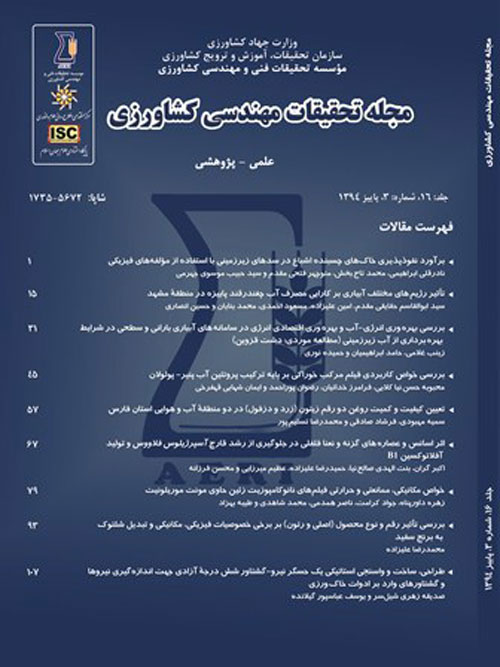The Effect of Conventional and Conservation Tillage on Forage Corn Yield in a Barley-Corn Rotation
Author(s):
Abstract:
High intensity evaporation from the soil surface due to low air humidity and poor soilstructure and organic matter are constraints of agriculture in arid and semi-arid regions ofIran. Regionally, maintaining plant residue with tillage management is one method to improve these conditions. In this study, for a barley-corn rotation, four barley residue management methods for standing stubble (burning, burying, incorporating and leaving on the surface)were compared over four years at Isfahan Kabootar Abad Agricultural Research Station. The experiment was conducted using a randomized complete block design with six treatments and three replications. The tillage treatments for corn (second crop) were applied to the same plot every year and the plots were conventionally plowed every year for the first crop (barley).The first year results showed that no-tillage treatments reduced the yield due to insufficient contact of seed and soil which caused an inadequate number of seedlings per square meter.However, providing better seed-soil contact in subsequent years resulted in no significantdifference in the yield of the no-tillage treatment with other treatments. There was also no significant difference in yield and other crop establishment parameters between the othe treatments during the four years of the study. Incorporation, leaving the residue on the surface and burying to a depth of 25 cm resulted in 20%, 18%, 13% increases, respectively, in the average organic matter compared with burning after four years of testing. Results also showed that the earthworm population under the conventional method was significantly lower than for the no-till and reduced-till treatments. No significant difference in root dry weight to a depth of 60 cm was observed between treatments. After four years, the results of the study indicated that the forage corn production under no-tillage and reduced tillage had no adverse effect on biomass yield and can be an alternative method to the current tillage method. Therefore, anannual compilation system that combines conventional tillage for barley and reduced tillagefor corn production (after barley) is an alternative to reduce soil moisture evaporation insummer, increase soil organic matter and improve soil structure (increase population ofearthworms) instead of conventional tillage operations.
Keywords:
Language:
Persian
Published:
Journal of Agricultural Engineering Research, Volume:12 Issue: 1, 2011
Page:
83
https://magiran.com/p884126
دانلود و مطالعه متن این مقاله با یکی از روشهای زیر امکان پذیر است:
اشتراک شخصی
با عضویت و پرداخت آنلاین حق اشتراک یکساله به مبلغ 1,390,000ريال میتوانید 70 عنوان مطلب دانلود کنید!
اشتراک سازمانی
به کتابخانه دانشگاه یا محل کار خود پیشنهاد کنید تا اشتراک سازمانی این پایگاه را برای دسترسی نامحدود همه کاربران به متن مطالب تهیه نمایند!
توجه!
- حق عضویت دریافتی صرف حمایت از نشریات عضو و نگهداری، تکمیل و توسعه مگیران میشود.
- پرداخت حق اشتراک و دانلود مقالات اجازه بازنشر آن در سایر رسانههای چاپی و دیجیتال را به کاربر نمیدهد.
In order to view content subscription is required
Personal subscription
Subscribe magiran.com for 70 € euros via PayPal and download 70 articles during a year.
Organization subscription
Please contact us to subscribe your university or library for unlimited access!


